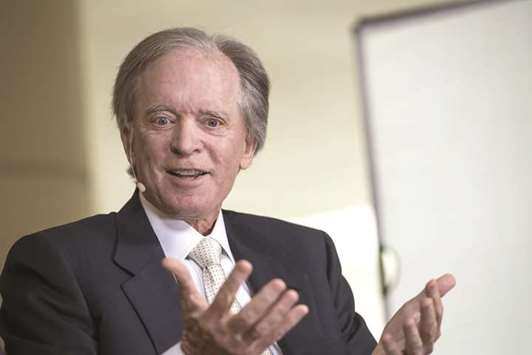Stop me if you’ve heard this one before: A famous bond fund manager is warning of the end of the three-decade bull market in bonds.
Bill Gross is the latest to sound the alarm, after seeing the strongest year-over-year wage growth since the recession. It would take a sustained move in 10-year Treasury yields above 2.4% to convince Gross of a reversal in the long-term downtrend. The yield flirted with that level on Friday, but failed to bust through as speculation North Korea was planning another missile test spurred haven buying.
“If we move above 2.4%, there is a chance that this long-term bull market in bonds is broken and bond investors should be on the defensive instead of the offensive,” Gross, manager of the Janus Henderson Global Unconstrained Bond Fund, said on Friday in an interview on Bloomberg TV. To get there, wages and inflation will need to be on the rise, he said.
The Treasury market is on its longest losing streak of 2017, falling for four straight weeks, as the lowest jobless rate since 2001 and rising hourly earnings breed optimism about the economy and boost bets on rate hikes. The 10-year yield ended last week at 2.36%, the highest closing level since July.
The next trigger for higher yields may come from reports on inflation, which Federal Reserve Chair Janet Yellen has called a “mystery” for remaining tame amid job-market strength. By at least one measure due this week, price growth may again rise above the central bank’s 2% target. The September consumer price index is expected to climb 2.3% from a year earlier, up from 1.9% the prior month.
With quicker inflation and stable markets, a December Fed hike is a “slam dunk,” Gross said. Traders are also coming around to that view: The implied odds that the central bank will raise rates by year-end have jumped to about 70%, based on overnight index swaps and the effective fed funds rate.
Meanwhile, options traders are betting on a Treasuries selloff that drives yields through Gross’s key level.
Demand is rising for put options on 10-year futures that expire in three weeks. Traders have amassed the biggest position in options with a strike price of 124.5, which equates to a 2.45% 10-year yield. Others target 124 and 123.5, which align with yields of 2.52% and 2.55%, respectively.
Of course, it’s been a repeated lesson in humility for investors and strategists calling for rising rates. Gross himself cautioned in January that a 10-year yield above 2.6% on a weekly or monthly basis would signal a bear market. It edged above that level in March, but failed to hold. Maybe this time’s for real. Maybe President Donald Trump’s nominee for the next Fed chair will be the final straw. Or maybe traders will have to try to break the 30-year trend one basis point at a time, starting this week.
US bond market is closed today for Columbus Day. It’s another back-loaded week of economic data, with retail sales and CPI readings on October 10 has NFIB small business optimism, while October 11 brings MBA mortgage applications and JOLTS job openings ahead of the September FOMC meeting minutes. October 12: Various measures of PPI, initial jobless claims, Bloomberg consumer comfort. October 13: CPI, retail sales, real average earnings, business inventories and U of Michigan sentiment, current conditions and inflation expectations.
Fed speakers will be out in full force as speculation swirls about the central bank’s next leader.

Gross: Bond investors should be on the defensive.
